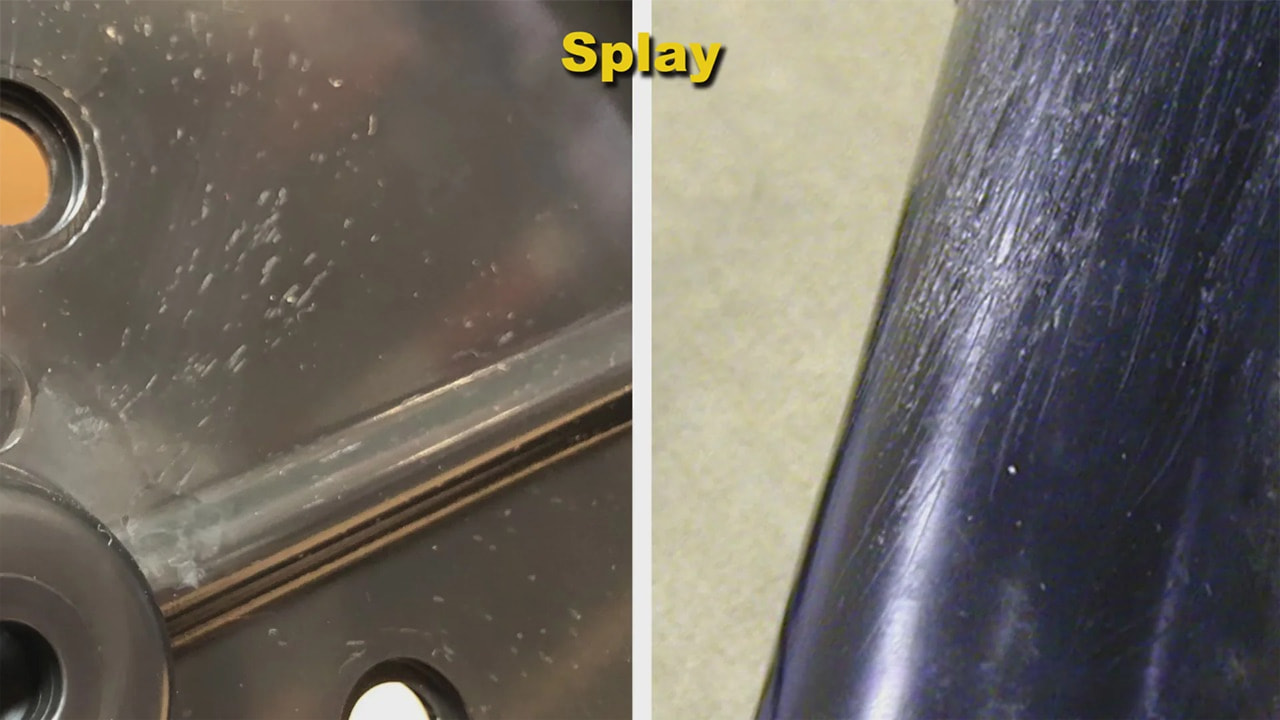Spreizung ist ein häufiger kosmetischer Fehler, der während des Spritzgießprozesses auftreten kann. Als Profi SpritzgießherstellerIn diesem Leitfaden erfahren Sie alles, was Sie über die Ursachen von Spreizungen an Spritzgussteilen und deren Vermeidung wissen müssen.
Was ist Spreizung beim Spritzgießen?
Spreizen bezieht sich auf die silbrigen oder weißen Schlieren, die auf der Oberfläche von spritzgegossenen Kunststoffteilen auftreten können. Sie entstehen in der Regel, wenn sich winzige Gasbläschen im Kunststoffmaterial bilden und beim Füllen des Formhohlraums über die Oberfläche des Teils gezogen werden.
Das Endergebnis ist ein Teil mit dünnen, kratzartigen Abdrücken auf der Oberfläche. Die Spreizung wirkt sich zwar hauptsächlich auf das Aussehen aus, kann aber auch die Festigkeit von Spritzgussteilen beeinträchtigen, wenn sie stark genug ist.

Spreizung wird häufig mit ähnlichen Bauteilfehlern wie Fließlinien, Oberflächenkratzern, verunreinigungsbedingter Delamination und Abplatzungen verwechselt. Bei genauer Betrachtung weisen echte Spreizungsdefekte jedoch einige Unterscheidungsmerkmale auf:
- Spreizmarken folgen in der Regel der Richtung des Schmelzeflusses durch die Form.
- Die Streifen erscheinen oft silberfarben oder weiß.
- Die Flecken sind in der Regel dünn und sehen wie Kratzer auf der Oberfläche aus.
- Sie können zufällig auftreten oder immer wieder in demselben Bereich auftreten.
Was verursacht Spreizung beim Spritzgießen?
Die Hauptursache für Spreizfehler ist Feuchtigkeit die während des Gießens im Kunststoff eingeschlossen werden. Aber auch bloße Hitze und Scherkräfte können zur Spreizung beitragen.
Hier sind die häufigsten Ursachen:
Luftfeuchtigkeit
Feuchtigkeit ist die häufigste Ursache für Spreizung. Wenn Kunstharz Spuren von Wasser enthält, verdampft es zu Dampf, wenn es der starken Hitze im Spritzgusszylinder ausgesetzt ist.
Wenn die Kunststoffschmelze den Formhohlraum ausfüllt, wandern diese Dampfblasen an die Oberfläche und verfestigen sich zu Kratzern und Markierungen.
Hygroskopische Harze wie Nylon und Polycarbonat nehmen leicht Luftfeuchtigkeit auf und müssen vor dem Verformen gut getrocknet werden. Aber auch nicht hygroskopische Materialien benötigen nur geringe Mengen an Feuchtigkeit, um Probleme zu verursachen.
Wasser kann während des Transports, der Lagerung, der Vorverarbeitung und sogar durch Leckagen in den Anlagen unbeabsichtigt in das Harz gelangen.
Wärme
Übermäßige Hitzeeinwirkung kann auch zu spreizungsartigen Defekten an Spritzgussteilen führen. Eine Überhitzung des Kunststoffs kann zu einem Materialabbau führen, der Gase freisetzt, die beim Ausstoßen auf der Oberfläche mitgerissen werden.
Mögliche hitzebedingte Ursachen sind:
- Fass- oder Düsentemperaturen zu hoch eingestellt
- Übermäßiger Gegendruck schert und überhitzt das Harz
- Schlechte Temperaturkontrolle verursacht Schwankungen
- Zu lange Verweilzeit im Fass
Scheren
Bereiche mit hoher Scherung in der Spritzgießmaschine und im Werkzeug können mechanisch Gase an die Oberfläche der Teile ziehen. Diese scherungsbedingten Spreizungsdefekte treten häufig immer an derselben Stelle auf.
Typische scherungsbedingte Ursachen:
- Hohe Schneckendrehzahl während der Plastifizierung
- Ungeeignete Größe des Anschnitts verursacht Scherung
- Behinderungen oder Einschränkungen im Kanalsystem
Wie man Spreizungsdefekte vermeidet
Hier sind 7 Tipps zur Vermeidung von Spreizung bei Ihren Spritzgussteilen:
1. Spreizsichere Materialien verwenden
Einige Harze wie Acryl, ABS, Polypropylen und Polyethylen sind weniger anfällig für Ausdehnung als hygroskopische Optionen wie Nylon oder Polycarbonat.
2. Materialien gründlich trocknen
Verwenden Sie einen geeigneten industriellen Entfeuchtungstrockner, um dem Harz vor dem Gießen die Feuchtigkeit zu entziehen. Befolgen Sie sorgfältig die Herstellerangaben für die optimale Temperatur und Verweilzeit.
3. Niedrigere Lauftemperaturen
Verringern Sie die Zylinder-, Düsen- und Formtemperaturen auf die empfohlenen Werte, um eine Materialzersetzung zu verhindern. Beginnen Sie konservativ und arbeiten Sie sich langsam hoch.
4. Aufenthaltsdauer begrenzen
Dimensionieren Sie den Einspritzzylinder und die Schussgröße für die Form, um die Verweildauer des Harzes im heißen Zylinder zu begrenzen. Dadurch wird die Gefahr einer Überhitzung verringert.
5. Optimierung der Einspritzgeschwindigkeiten
Passen Sie die Füllgeschwindigkeitsprofile an - verlangsamen Sie bestimmte Abschnitte -, um die Scherung durch zu schnellen Fluss zu minimieren. Allmähliche Übergänge sind ebenfalls hilfreich.
6. Ordnungsgemäße Entlüftung sicherstellen
Vergewissern Sie sich, dass das Entlüftungssystem in der Form einen ausreichenden Querschnitt hat, damit die Gase effizient entweichen können, ohne den Fluss zu behindern.
7. Gegendruck erhöhen
Eine Erhöhung des Gegendrucks kann die Plastifizierung und Dispersion der Gase verbessern und in einigen Fällen die Spreizung verringern. Achten Sie jedoch darauf, nicht zu überhitzen.
Behebung bestehender Spreizungsprobleme
Wenn bereits Spreizungsdefekte aufgetreten sind, gibt es einen systematischen Ansatz, um die Ursachen zu ermitteln und das Problem zu beheben:
1. Gründlich trockene Materialien
Unabhängig von der Art des Kunststoffs sollten Sie mit einem Feuchtigkeitsmessgerät prüfen, ob der Feuchtigkeitsgehalt des Harzes innerhalb der Spezifikationen liegt. Erhöhen Sie die Trockenzeit oder die Temperatur, falls sie zu hoch ist.
2. Niedrigere Form- und Schmelztemperaturen
Versuchen Sie, die Werkzeug- und Düsentemperaturen in kleinen Schritten zu senken. Lassen Sie den Änderungen mehr als 20 Minuten Zeit, um zu wirken, bevor Sie die Teile prüfen.
3. Tweak-Injektionsprofil
Ändern Sie Füllgeschwindigkeit, Übergangsgeschwindigkeiten, Drücke und Timing, um die Scherung zu minimieren. Verlangsamen Sie die Abschnitte, die Probleme verursachen, und verbessern Sie die schrittweisen Geschwindigkeitsänderungen.
4. Torgröße anpassen
Wenn um den Anschnitt herum immer wieder eine Spreizung auftritt, müssen Größe und Design geändert werden, um die Scherung zu verringern. Möglicherweise muss die Form geändert werden.
5. Prüfung auf Hindernisse
Untersuchen Sie Düsenspitzen, -kanäle und -entlüftungen auf Anzeichen von Verstopfungen oder Verengungen, die durch Scherung oder schlechte Entlüftung zu Spreizung führen.
6. Schneckendrehzahl reduzieren
Durch Verringern der Schneckendrehzahl lässt sich feststellen, ob eine Scherung im Inneren des Laufs die Ursache für die Spreizung ist. Wenn dies der Fall ist, sollten die Abdrücke abnehmen.
7. Unterer Gegendruck
Wie die Temperatur sollte auch der Gegendruck schrittweise reduziert werden, wenn der Verdacht auf hitzebedingte Ausdehnung besteht. Lassen Sie den Änderungen Zeit, um zu wirken.
Die methodische Bewertung und der Ausschluss aller Variablen, die die Spreizung beeinflussen, ist der Schlüssel zur Lösung aktueller Probleme und zur Vermeidung zukünftiger Probleme durch eine optimale Steuerung des Spritzgießprozesses.
Zusammenfassung
Kunststoff-Spritzgießverfahren, Vermeidung von Spreizung beim Spritzgießen, feuchtigkeitsbedingte Spreizungsdefekte, scherungsbedingte Spreizungsursachen, Wärme und Spreizung im Spritzgießverfahren, systematische Behebung bestehender Spreizungsdefekte
Streifendefekte, die auf schlecht kontrollierte Prozessparameter oder Materialbedingungen zurückzuführen sind, können die Qualität und Leistung von Spritzgussteilen erheblich beeinträchtigen. Doch mit Wachsamkeit und einem systematischen Ansatz lassen sich diese unangenehmen Silberstreifen beheben oder ganz vermeiden.
